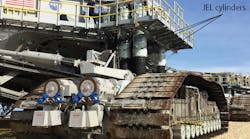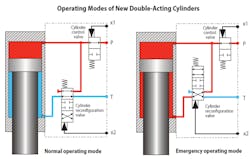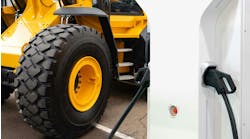New JEL Cylinders Give Youth and Vitality to NASA’s Old Crawler Transporters
Since 1965, two specialized crawler transporters have had the right stuff to transport NASA spacecraft from the vehicle assembly building to the launch pads at Kennedy Space Center, Florida. But this is a new century, and the National Aeronautics and Space Administration is developing a new generation of Orion spacecraft. They will need equally beefy transporters capable of carrying 50% more weight.
Hunger Hydraulik was hired to help launch these new transporters. Hunger proposed new jacking, equalizing, and leveling (JEL) cylinders to deliver the extra capacity, but this company would also add some new features to improve the availability, reliability, and safety of the transporters’ systems. After cylinder design approval and manufacture, they would have to pass muster in a dynamic test rig and then in the crawler transporter itself.
A Bit of Background
The Kennedy Space Center’s two original crawler transporters were built between 1963 and 1965 to transport the fully assembled Saturn V rocket as well as the Apollo spacecraft and launch platform from the assembly building to the launch pads. Later, the crawler transporters were used for Space Lab, Apollo-Soyuz and all Space Shuttle missions.
For loads as high as 6,000 tons, the hydraulic JEL system supplements the vehicles’ eight chain tracks, two in each undercarriage. These tracks measure 10 m long and 35 m wide.
The JEL system was designed with 16 single-acting hydraulic cylinders, four of them in each corner of the transporter’s undercarriage. With this system, the crawler transporter could lift the completely equipped launch platform from its parking slot in the vehicle assembly building, level it during the transport and for the launch pad ramp drive, and drop it on the launch pad slot. To realize these functions, the hydraulic cylinders have a stroke length of 2 m, which also provides a compensation angle of 5 deg for the launch pad ramps.
Spherical bearings mounted on rod end and bottom of each cylinder gave them the required freedom of motion during steering and leveling operations. Load control was done by remote controlled pressure-control valves on each cylinder. It was also possible to hydraulically shut off a single JEL cylinder and to maintain the load with the three remaining JEL cylinders for emergency operation. The central hydraulic power unit is installed in the center of the load frame structure and provides all sixteen JEL cylinders with pressurized hydraulic fluid.
The original JEL cylinders had to be exchanged so the new generation of crawlers could handle heavier workloads for another 20 years supporting human spaceflight at NASA.
Scope of Work
The specification for the new JEL cylinders was worked out by NASA, with assistance proposed by experts at Hunger Hydraulik. The main focus was on increasing load capacity and on safety and reliability as well. Therefore, the requirements for the new JEL cylinder project were:
- Load increase for the JEL system of 50%, keeping the existing hydraulic power unit within given pressure and oil flow parameters;
- Using the same installation space and mounting interfaces in the crawler transporter;
- Improving the design and construction of the spherical bearings;
- Offering a multi-level safety concept for the hydraulic load control;
- Easier installation and handling of the JEL cylinders;
- Enhanced corrosion protection for the piston rods in the offshorelike environment at Kennedy Space Center;
- Engineering and manufacture of a one-to-one scale dynamic test rig.
Based on these requirements, a risk analysis with handling options was carried out for the existing JEL cylinder design as well as for the new cylinder drafts. This analyzed the effects of different failures, such as a main seal malfunction, a pressure pipe or pressure hose rupture, or a break of a spherical bearing or pin. As a result, it could be shown that the new JEL cylinder design improves the system behavior and reduces the consequences from any of these malfunctions, ensuring that a transport task can be finished without delay and without adding risk.
A cylinder design was developed and introduced to NASA to fulfill all the conditions mentioned above. After detailed investigation and after getting the preliminary approval for the design and calculations, two prototype cylinders were built to prove their manufacturability, performance, and quality. Later, after the tests were successfully completed, the working JEL cylinders were manufactured for the first crawler transporter.
The new JEL cylinders were designed and calculated according to ASME standards with flanged cylinder head and bottom for easy maintenance. To realize 50% more load capacity using the same power unit in the crawler transporter, it was necessary to increase the diameter of the cylinders accordingly. At the same time the space limitations in the given crawler transporter structure had to be considered. Instead of the original spherical bearings with pin and clevis, designers specified maintenance-free spherical ball joints. In addition, the mounting interfaces to the crawler transporter were equipped with adapter plates having fast-mounting interlocks. Instead of in-pipe mounted safety valves, a hydraulic manifold block was provided on each cylinder.
The new JEL cylinders still lift and lower loads under gravity, but they are now double acting. This offers some advantages compared to the old, single-acting cylinders. On one hand, the loaded seal is the piston seal now, and is surrounded by the controlled and clean hydraulic fluid—protecting it from environmental influences. On the other hand, the piston rod seal can now act as a secondary emergency seal if the JEL cylinder would be used in single operation mode controlled by a special setup in the manifold block. To activate the emergency mode, only the cylinder reconfiguration valve needs to be activated. To have the lowest possible load variation in this emergency mode, the rod diameter was designed as big as possible.
The original JEL cylinders were single acting, but the new ones are double-acting, to provide more versatile operation, especially when compensating for malfunctions, however unlikely.
Seal design—The seal arrangement in the JEL cylinders is key to holding the load under all circumstances and to guaranteeing a stroke movement free of stick slip effects or other vibrations. The dynamic seals on the piston and in the cylinder cap were selected primarily from standard Hunger products.
Engineered plastic compound bearing elements guide the piston and the piston rod and withstand any possible side load. They consist of a POM-PTFE-bronze compound and offer low friction and no stick slip movement, especially under low-speed motion. The shape of the bearing elements grants a 3-mm clearance between the other moving parts and can at the same time directly support the seal elements in axial direction without any extrusion gap.
Piston rod coating—The piston rods are covered with Hunger’s Ceraplate thermal sprayed metal oxide coating to protect them in the offshore-like sea atmosphere at Kennedy Space Center. This coating provides enhanced corrosion protection when the rods are exposed to the sea atmosphere for a longer time when the crawler transporter is not used. The performance of the coating is tested and certified by independent institutes with regard to layer composition, hardness, and corrosion resistance according DIN EN ISO 9227.
Piston rods of the JEL cylinders receive a proprietary Ceraplate coating to provide high corrosion resistance, high hardness, and a smooth surface finish for low friction and long life.
Spherical bearings—To improve the longevity and reliability of the JEL cylinder bearings, the design was changed from steel ball bearings with steel clevis and pin to maintenance-free spherical ball joints. The old bearings sometimes cracked, but the new design is expected to be more robust and should withstand even overload conditions. The spherical ball joints offer a larger bearing area, which reduces the contact stress in the material. This design is also free of bending stresses in all loaded parts.
The bearing material is a maintenance-free Hunger H-Glide lining, combined with a hardened steel ball as a counterpart. It allows a free tilting of 7 deg in any direction, with a maximum compressive strength in the lining of 160 MPa. An inner retention pin keeps both bearing parts together. The bottom side spherical ball joints are equipped with an anti-rotation device to avoid uncontrolled rotation of the JEL cylinders.
Handling and Installation—Because of its size, any service and maintenance of the crawler transporter is typically done outdoors, using mobile cranes to handle heavier parts. In case of the JEL cylinders, the installation space requires them to be put under the upper load frame structure—a difficult task if the cylinder is hanging on a crane hook. Therefore, a lifting fixture allowing much easier handling and installation of the JEL cylinders in the crawler was developed.
Furthermore, the mounting interface between the crawler transporter and the JEL cylinder will be modified with adapter plates with fast mounting interlocks. The adapter plates will be flanged, offering better accessibility within the crawler transporter structure.
Testing the Cylinders
An extensive test program had to be developed and executed to prove the performance of the new JEL cylinder design. This program consisted of static tests, dynamic full-load tests, and real application tests of the crawler transporter.
Static tests were carried out on the hydraulic test rig at Walter Hunger GmbH & Co. The static load frame allowed full pressure tests of the JEL cylinders, not only in the end-stroke positions but also in a mid-stroke position. Additionally, all functions of the manifold block were tested, as was freedom-of-motion of the spherical bearings.
A dynamic test rig was developed and built to carry out dynamic tests with the JEL cylinders under full load. This consisted of a vertical load frame with moveable mid-support and load cylinder, a hydraulic power unit with two independent controllable hydraulic axes, as well as the necessary control and recording hardware and software. The JEL cylinder was installed in the lower part of the test rig in one axis with the load cylinder.
The dynamic test program contained sequences of full stroke cycles, smaller oscillations, and load variations. Emergency load conditions were also tested. During all tests, system ad JEL cylinder parameters, such as pressure, stroke position, friction, number of cycles, etc., were recorded for later evaluation. After finishing the dynamic test program each of the tested JEL cylinders were dismantled and inspected in detail. Based on these findings, smaller design adjustments were made for the manufacturing units. Longevity, reliability, and performance of each cylinder part were evaluated.
Drive Tests with the Crawler Transporter
To verify that the new JEL cylinders will fit into the given crawler transporter structure and perform as needed, the two prototype cylinders (instead of two old cylinders) were installed in one undercarriage unit. Doing so allowed handling and all the interfaces to be tested. After the lifting tests, the crawler transporter was driven from the vehicle assembly building to one launch pad and back. This test drive ensured that cornering, lifting, and a ramp ride would be successful. The results were analyzed and discussed, and the necessary changes were done for the JEL cylinder production units.
Finally, the first crawler transporter was completely equipped with the working JEL cylinders. The final drive and load tests proved successful once extensive test rides were completed. The first new-generation crawler transporter is now ready for future NASA missions.
lngo Ruhlicke, Ph.D., is the head of the Project and Export Departments of Walter Hunger GmbH & Co. KG in Lohr am Main, Germany. For more information, visit the company's website or call (419) 666-4510.




